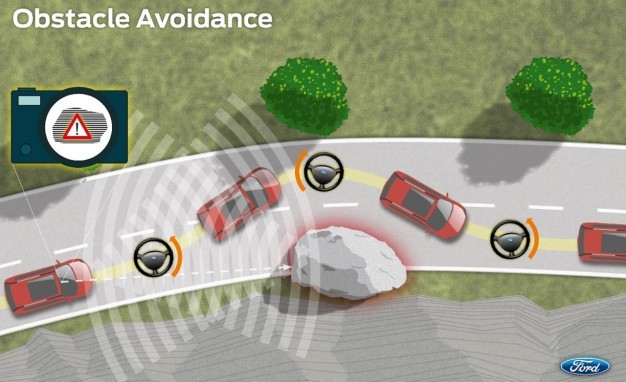Ford Obstacle Avoidance Steers Drivers Away From Danger [VIDEO]
Self-braking safety systems are now fitted to cars at both ends of the market - from the £10,000 Volkswagen Up to the £60,000 Mercedes S-Class - but Ford is hoping to go a step further, by adding automatic steering to avoid accidents.

On a visit to Ford's Lommel proving ground in Belgium, IBTimes UK was given access to the latest in crash avoidance technology, which can detect slow or stationary obstacles such as pedestrians, cyclists, large animals or other cars, and steer around them at up to 60kph (38mph).
Still under development and not expected to be included in new Ford models until the end of the decade, Obstacle Avoidance could be used in the future as a last-ditch attempt to avoid an accident where the driver may have fallen unconscious.
The system is being developed in partnership with BMW, Daimler, Fiat, Volvo and Volkswagen, who will share data from Ford's tests as part of a consortium to develop their own systems; Ford will present its findings from the tests at the end of the year.
Using six radars, sonar sensors and a camera, the system constantly monitors its surroundings and the actions of fellow road users. Should the car in front brake heavily, or be stationary when entering the system's 200 metre range of sight, the driver will first be alerted with red flashing lights on the dashboard, an audible alarm and vibration through the accelerator pedal, which starts to move upwards against the driver's foot.
If no action is taken within 1.5 seconds of the alarm sounding and the threat of a collision is still present, the system will take control, applying the brakes heavily and steering left then right to avoid the stationary object and return to the same lane as before.
The system is designed to apply maximum brake pressure initially, before adjusting the pressure on the rear brakes to help the car steer around the object more tightly than if braking was applied equally to all four corner.
Although not yet a feature of the prototype system, the car will then slow to a gradual halt if the driver is yet to give any input to the controls. Ford hopes to make the system intelligent enough to stop safely at the side of the road, whether it's a country lane or motorway.
Driver override
If the driver had fallen asleep and is awoken by the movement of the steering wheel, any input given by them to the wheel or pedals will override the car's control.
IBTimes UK was a passenger in a Ford Focus with the system installed and, having sat through five demonstrations, can confirm the system's effectiveness. Even at this early stage in development, the car accurately performed the manoeuvre.
If the car's radars cannot see a safe space to the left or right of the obstacle steering input will not be applied, Ford safety project manager Tom Overington said, adding the US manufacturer is "leading the way" when it comes to accident avoidance technologies.
Legislation
But there's a sticking point, as no country yet allows a car's safety systems to take control of the steering, no matter how much time the driver is given to react, or how easily they can retake control.
Ford remains optimistic that it can develop the system enough to be deemed legal, a milestone Overington claims could be reached "in two years" - and he added that Ford plans to continue developing the technology in the meantime, as well as broadening its uses, such as preventing a driver from pulling out of a junction in front of unseen traffic.
Nissan and Tesla firmly believe the autonomous car will be roaming the streets in the next three to six years, and although Ford is yet to make such a bold claim in public, developing intelligent crash avoidance technology like this shows it's on a similar, self-driven course.
Read More: Ford Focus Electric: First Drive
© Copyright IBTimes 2025. All rights reserved.






















